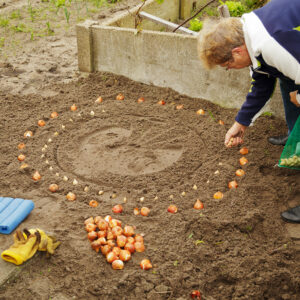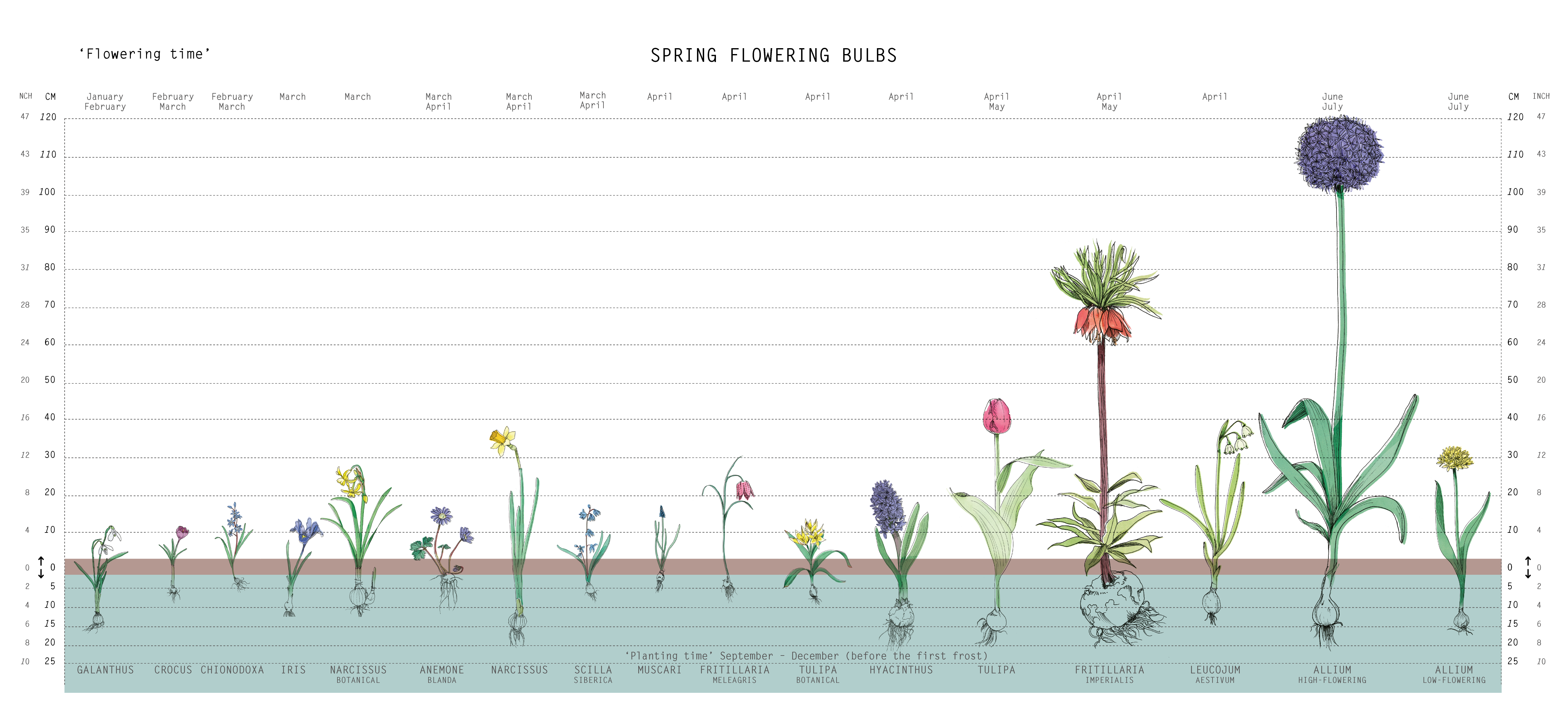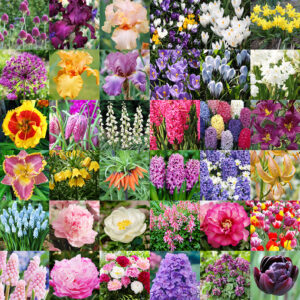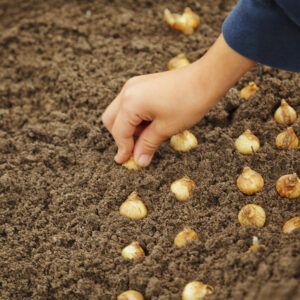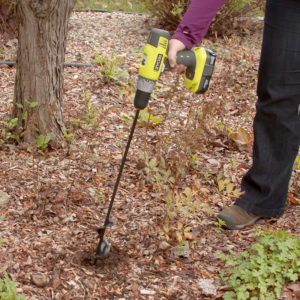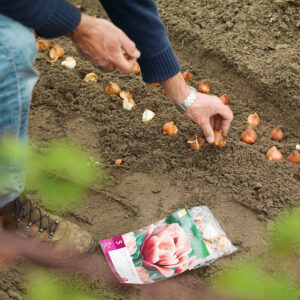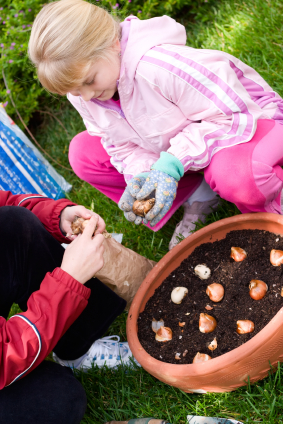Have you missed out on spring blooms in the past? Are you unsure of when to plant flower bulbs for spring blooms? If you answered yes to either of these questions you may be new to planting flower bulbs in fall. To ensure your spring garden is full of color, fragrance, and texture you will want to be sure you load your yard up with plenty of bulbs this fall. Fall planted flower bulbs are an excellent choice for new gardeners. They require minimal care once growing and are generally easy to plant. However, to have the best success rate with fall-planted bulbs you probably have some questions. The good news is we have answers to all of your questions about planting flower bulbs in fall.
Planting Bulbs in Fall: Your New Favorite Fall Activity
Are spring-flowering bulbs and fall-planted bulbs the same thing?
When shopping for flower bulbs online you may see the bulbs listed as fall-planted bulbs, fall bulbs, or spring-blooming bulbs. Essentially all three titles mean the same thing.
Flower bulbs that are planted in the fall have a high likelihood of blooming the following spring. However, there are exceptions to that rule. For example, oriental lilies can be planted in the fall but will bloom in mid-summer. There are other bulbs that are planted in the fall with a summer bloom time. However, those fall-planted summer-blooming bulbs are exceptions. The majority of bulbs that are planted in fall will bloom in spring.
Why do you plant bulbs in the fall?
The life cycle of the bulb and temperature requirements of these bulbs are the two main reasons they are planted at specific times of the year. Cold temperatures are required for fall-planted bulbs to be able to produce a flower bud. A range of cool temperatures below 50 degrees during the day consistently is necessary for most fall-planted bulbs. These cold temperatures are necessary for at least 8 weeks for some fall bulbs and up to 16 weeks for other fall bulbs.
Flower bulbs require a period of dormancy to produce flowers. This need for dormancy is another factor in why bulbs that bloom in spring are planted in fall. When the bulbs are planted they are in a dormant state. Upon planting they grow roots for several months and continue to gain energy in preparation for their spring show. This display of blooms requires a great deal of energy from the bulbs. So much energy is put out by the blooms that after they are done blooming they will go dormant again. During this dormant time, they are again gathering energy for the next 10-11 months in preparation for the next springs blooms.
When do you plant bulbs for spring?
The majority of flower bulbs that bloom in spring are planted in fall. Planting time will vary based on your climate and seasonal temperatures. The best time to plant bulbs in fall is when your daytime temperatures are consistently in the 60’s or lower. Therefore, gardeners in northern climates with cooler fall temperatures will be able to plant their fall bulbs sooner than gardeners in warm climates.
In areas where the ground freezes for winter fall bulbs can be planted anytime before the ground is frozen solid. If a light frost occurs that is ok and will not have an adverse effect on your bulbs. People who are planting fall bulbs in warmer climates can wait to plant until late November, December and even into early January.
When do you buy bulbs for planting in fall?
Reserve your fall-planted bulbs starting in spring through summer to ensure you get the varieties you like. They will be shipped later when it is close to planting time in your area. Bulbs for planting in fall are available for purchasing in retail stores as early as Labor Day. Most online retailers such as Holland Bulb Farms and Tulip World offer fall pre-ordering as early as July and begin their fall bulb shipping in mid-September.
What bulbs to plant in fall
5 most popular bulbs for fall planting:
Common but less known bulbs for fall planting:
- Muscari
- Fritillaria
- Snowdrops
- Dutch Iris
- Bearded Iris
- Squills
- Glory of the Snow
- Foxtail Lilies
- Lycoris
- Anemone
- Snowflakes
- Buttercups
- Camassia
The most beginner-friendly bulbs for planting in fall are daffodils. Daffodils are deer resistant, not bothered by squirrels, grow in a wide range of hardiness zones (3-8), are reliable perennials, and tend to multiply slowly. Read our Beginners Guide to Growing Daffodils for more details on getting started with planting daffodil bulbs.
How to Plant Bulbs in Fall
Planting bulbs in the fall is pretty simple. It can also be a fun fall activity to get the whole family involved with. For existing planting beds, you will want to make sure the soil the bulbs are to be planted in drains well. If there is mulch in the planting bed the mulch needs to be pulled away from the soil before you begin digging. For new planting beds, you will need to remove the sod from the planting area prior to planting.
Flower bulb planting depth and direction
Proper planting depth is the most important planting consideration when planting your fall bulbs. The bulbs will most likely have planting depth instructions on the label of the package. Additionally, most flower bulb retail websites list the planting depth for each individual item on their website. However, if these resources are not available to you a general rule of thumb is to plant the bulb 2-3 times the height of the bulb. If a bulb is 1″ tall plant it 2-3″ deep. Another consideration for planting depth when it comes to fall-planted flower bulbs, too deep is better than too shallow.
Planting the bulb with the correct end facing up is also important. For true bulbs like tulips and daffodils, the pointed end is noticeable and is always the end that should face the sky. Bulbs like anemone often don’t have a pointed end. For bulbs that you can’t tell which side is up, it is best to lay the bulbs on their side. They will reach for the light and straighten themselves out all on their own.
Fall Bulb Planting Methods
Fall-planted bulbs can be planted in large groupings, individual planting holes, bouquet planted or planted in a trench. How you decide to plant your bulbs will depend on the planting area.
Planting bulbs in mass
For a large block of color plant the bulbs in a large group in a planting area. Dig out the entire planting area to the proper planting depth. Place the bulbs with the pointed end up if applicable, and spacing based on package directions. Once all of the bulbs are placed in the planting area you can cover them with soil.
Planting bulbs in individual holes
Bulbs can be planted individually using a bulb auger or bulb planter. Using these devices to plant your bulbs makes individual planting easy. Planting bulbs individually in each planting hole comes in handy when you need to fill in an area here or there. Individual planting also works well for small space planting areas.
Bouquet planting
Bouquet planting involves planting several bulbs in the same planting hole. By using the bouquet planting method when the flowers grow in spring they will grow like a bouquet with several flowers in one clump. To bouquet plant, your bulbs dig a hole that is wide enough to fit 5-7 bulbs. Place the bulbs in the hole close together, but not touching. When the bulbs have been placed in the hole backfill with soil.
Planting flower bulbs in a trench
Planting in a trench is useful when you want a border of blooms. If you want to create a border of flowers in the front of your planting bed this method is best. Create a trench by digging out the length of the planting area, and width that you want to fill in. When digging the trench make sure you are digging to the proper depth the bulbs are to be planted.
Can I plant fall bulbs in containers?
It is possible to plant bulbs in containers in fall. However, certain climates will have better success with planting fall bulbs in containers. Temperate climates that have cooler temperatures in winter, but not major swings in temperature will have more success with planting bulbs in containers.
Northern climates and areas where the temperature regularly fluctuates from freezing to thawing will face challenges when growing fall bulbs in containers. The freeze-thaw cycles can be detrimental to fall-planted flower bulbs. The bulbs will freeze solid and then thaw out when it warms up. When this happens and the bulbs are not insulated the bulbs will turn to mush. If you want to plant fall bulbs in pots and live in a variable climate you will need to insulate the pots. You can insulate the pots with straw bales, a large blanket, or foam. Sinking the planted pots into the ground is the best way of insulating the pots and bulbs.
Do fall-planted bulbs need to be dug up in spring?
Typically you will not need to dig up the bulbs you planted in fall after they bloom in spring. This is one of the features gardeners enjoy about fall bulbs. Several types of bulbs that are planted in fall are reliable perennials. Once they are planted they can stay put for several years. Daffodils, allium, crocus, muscari, hyacinths, and certain tulips are reliable perennial bulbs.
Some tulips aren’t as reliable for returning after the first year. If you want a large and showy display of tulips each year, you may need to re-plant every fall. Therefore, the bulbs may be dug up in spring so annuals can be planted in their place. When the annuals are done for the season bulbs are planting in the area again. Re-planting tulips each year and replacing them with annual flowers is more likely to be done in commercial settings. However, some homeowners do like to be certain they will have the showiest display of blooms each spring and will re-plant every fall.
Planting Flower Bulbs in Fall for Blooms in Spring
Don’t miss the boat next spring! Be sure to include planting flower bulbs fall to your list of activities so when spring rolls around you will have a yard full of flowers to enjoy. Planning for fall planting in spring and summer is a surefire way to ensure you will have bulbs in time for planting. For more detailed planting information on gardening with flower bulbs check out all of our articles for beginner gardeners.


